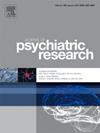The mediation effect of the inferior-parietal cortex and globus pallidus on the relationship between family conflict and major depressive disorder
IF 3.7
2区 医学
Q1 PSYCHIATRY
引用次数: 0
Abstract
Objective
Family conflict is an important risk factor for major depressive disorder (MDD) and is associated with structural alterations in the brain. However, it is unclear whether structural alterations associated with family conflict would contribute to depression. This study aims to investigate the neuroimaging characteristics that connect family conflict with depression.
Methods
This study included 54 healthy controls and 53 antidepressant-free patients with MDD. Both groups completed the Beck Depression Inventory-II, the simplified Chinese version of the Family Environment Scale, and the Childhood Trauma Questionnaire. Structural Magnetic Resonance Imaging data was collected to measure cortical thickness and regional gray matter volumes.
Results
Family conflict has a significant effect on depression diagnosis. Higher levels of family conflict were positively associated with symptoms of sadness, guilty feelings, and punishment feelings in patients, as well as with cortical thickness in the right inferior-parietal cluster and the volumes of the left globus pallidus in all participants. In the patient group, cortical thickness in the right inferior-parietal cluster and volume of the left globus pallidus were negatively related to symptoms of sadness and guilty feelings, respectively. The structural alteration in the right inferior-parietal cluster mediated the relationship of family conflict and sadness, whereas changes in the globus pallidus mediated the associations between family conflict and both depression and guilty feelings in patients.
Conclusion
Findings revealed the relationships between family conflict and depression, including both depression diagnosis and specific symptoms. Cortical thickness in the right inferior-parietal cortex and the volume of the left globus pallidus played mediating roles in these relationships, indicating the important contributions of these brain regions to the effect of family conflict on depression.
下顶叶皮层和球状苍白球对家庭冲突与重度抑郁障碍之间关系的中介效应。
目的:家庭冲突是导致重度抑郁障碍(MDD)的一个重要风险因素,并且与大脑结构的改变有关。然而,目前尚不清楚与家庭冲突相关的结构改变是否会导致抑郁症。本研究旨在探讨家庭冲突与抑郁症相关的神经影像学特征:本研究包括 54 名健康对照组和 53 名未服用抗抑郁药的 MDD 患者。两组患者均填写了贝克抑郁量表-II、简体中文版家庭环境量表和童年创伤问卷。研究人员还收集了结构磁共振成像数据,以测量皮质厚度和区域灰质体积:结果:家庭冲突对抑郁症诊断有明显影响。较高程度的家庭冲突与患者的悲伤症状、内疚感和惩罚感呈正相关,与所有参与者的右侧下顶叶群皮质厚度和左侧球状苍白球体积也呈正相关。在患者组中,右侧下顶叶皮层厚度和左侧球状苍白球体积分别与悲伤症状和内疚感呈负相关。右侧下顶叶群的结构变化介导了家庭冲突与悲伤的关系,而球丘的变化则介导了家庭冲突与患者抑郁和负罪感的关系:结论:研究结果揭示了家庭冲突与抑郁症之间的关系,包括抑郁症诊断和具体症状。右侧下顶叶皮层的皮质厚度和左侧球状苍白球的体积在这些关系中起着中介作用,表明这些脑区在家庭冲突对抑郁症的影响中起着重要作用。
本文章由计算机程序翻译,如有差异,请以英文原文为准。
求助全文
约1分钟内获得全文
求助全文
来源期刊

Journal of psychiatric research
医学-精神病学
CiteScore
7.30
自引率
2.10%
发文量
622
审稿时长
130 days
期刊介绍:
Founded in 1961 to report on the latest work in psychiatry and cognate disciplines, the Journal of Psychiatric Research is dedicated to innovative and timely studies of four important areas of research:
(1) clinical studies of all disciplines relating to psychiatric illness, as well as normal human behaviour, including biochemical, physiological, genetic, environmental, social, psychological and epidemiological factors;
(2) basic studies pertaining to psychiatry in such fields as neuropsychopharmacology, neuroendocrinology, electrophysiology, genetics, experimental psychology and epidemiology;
(3) the growing application of clinical laboratory techniques in psychiatry, including imagery and spectroscopy of the brain, molecular biology and computer sciences;
 求助内容:
求助内容: 应助结果提醒方式:
应助结果提醒方式:


